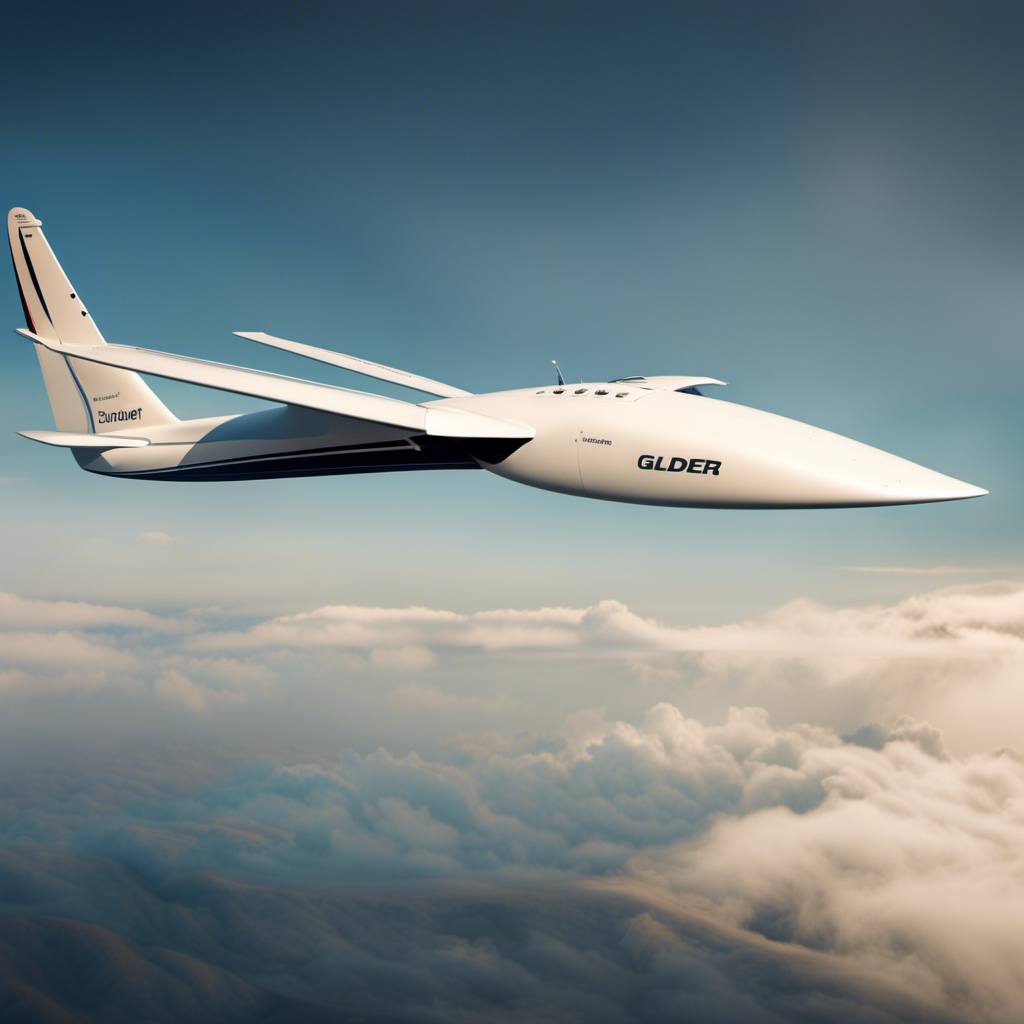Being a passionate glider, I’m always in awe of the different gliding methods that are available. From the elegance of classic sailplanes to the exhilarating rush of speed flying, there’s a style of gliding for every kind of adrenaline enthusiast.
Hang gliding, paragliding, powered paragliding – the options seem endless. And let’s not forget about the extraordinary techniques of ridge soaring, wave soaring, and dynamic soaring.
In this article, I’ll take you on a journey through the exhilarating world of gliding and explore the different types that will leave you in awe.
Key Takeaways
- There are four types of gliding techniques: aerotowing, ridge soaring, wave soaring, and dynamic soaring.
- Each type of gliding offers unique benefits, such as quick altitude gain and extended flight times with aerotowing, exhilarating experiences and breathtaking views with ridge soaring, reaching high altitudes and covering long distances with wave soaring, and achieving astonishing heights and vast distances with dynamic soaring.
- Maximizing flight efficiency in gliding involves techniques like energy transfer in dynamic soaring, exploiting wind gradients and different wind speeds at different altitudes, and extracting energy from the wind.
- Different types of gliding also offer distinct emotions and experiences, including varying levels of thrill, freedom, skillful maneuvering, serenity, and awe.
Traditional Sailplanes
Traditional sailplanes, also known as gliders, rely solely on atmospheric conditions to stay airborne. These magnificent aircraft have been used for decades to experience the thrill of soaring through the sky without the need for an engine.
Traditional sailplanes are designed with long wings and a sleek fuselage to maximize their gliding capabilities. To stay aloft, pilots utilize various soaring techniques, such as ridge soaring, where they fly along the edge of a mountain or hill to catch rising air currents.
Another technique is thermal soaring, where pilots search for areas of warm air rising from the ground, allowing them to gain altitude.
Hang gliding, on the other hand, offers a different kind of gliding experience.
Hang Gliding
Hang gliding is an exhilarating activity that allows me to experience the thrill of flying like a bird. By harnessing the power of wind, I can glide through the air and feel a sense of freedom and weightlessness.
It is a truly unique and awe-inspiring way to explore the skies and connect with nature.
Experiencing the thrill of flying like a bird
Soaring through the sky and feeling the rush of wind against your face is an incredible way to experience the thrill of flying like a bird. Gliding, also known as sailplaning, offers the unique opportunity to harness the power of wind and glide through the air.
Experiencing the joy of gliding is all about mastering the art of soaring. It involves using the natural elements, such as thermals and updrafts, to stay airborne for extended periods. The feeling of effortlessly riding the currents of air is truly exhilarating.
Gliders, also known as sailplanes, are specially designed aircraft without an engine. They rely solely on the power of the wind to stay aloft. Harnessing the power of wind and gliding through the air allows us to explore the skies and experience the freedom of flight in its purest form.
Harnessing the power of wind and gliding through the air
When you’re gliding through the air, you can feel the power of the wind as it propels you forward. Harnessing wind power is a remarkable feat that allows us to experience the exhilaration of flying effortlessly.
Gliding involves utilizing the natural forces of wind to stay aloft and move through the air. By carefully positioning ourselves in the wind’s path, we can achieve a state of weightlessness and freedom. With the help of specialized equipment, such as gliders or hang gliders, we can take to the skies and navigate the currents with ease.
This unique form of flight offers an incredible sense of serenity and adventure, as we soar through the vast expanse of the sky. Speaking of flight, one of the most popular forms of gliding is paragliding, which combines the simplicity of a parachute with the maneuverability of a glider.
Paragliding
You can experience the thrill of paragliding by soaring through the skies with a parachute-like wing. Paragliding is a recreational and competitive adventure sport that involves flying lightweight, foot-launched gliders. Safety is of utmost importance in paragliding, and it is crucial to follow proper techniques to ensure a successful flight. Here are some essential paragliding safety tips and techniques:
| Safety Tips | Techniques | Equipment |
|---|---|---|
| Check weather conditions | Launching and landing techniques | Glider |
| Proper training and certification | Thermalling and ridge soaring | Harness |
| Pre-flight checklist | Weight shifting and brake control | Reserve parachute |
| Stay within your skill level | Active piloting and wing control | Helmet |
Speed Flying
To experience the excitement of speed flying, strap on a small, high-performance wing and glide rapidly through the air. Speed flying is a thrilling sport that combines elements of paragliding and skiing. With a smaller wing and higher wing loading, speed flying allows for faster speeds and more dynamic maneuvers.
This adrenaline-fueled activity provides a unique perspective as you fly close to the ground and navigate through narrow canyons and steep slopes. The feeling of speed and freedom is unparalleled, and the rush of adrenaline is addictive. Speed flying is not for the faint of heart, but for those who seek adventure and the thrill of pushing their limits.
Now, let’s transition into the next section and explore powered paragliding, another exhilarating way to experience the joy of flight.
Powered Paragliding
After exploring the adrenaline-fueled world of speed flying, let’s now delve into another thrilling form of flight known as powered paragliding.
Powered paragliding combines the freedom of paragliding with the convenience of an engine. Picture yourself soaring through the sky, propelled by a lightweight motor strapped to your back, as you experience the exhilaration of flight.
With powered paragliding, you have the ability to take off from almost anywhere, making it accessible and convenient for enthusiasts. The powered paraglider consists of a paragliding wing and a paramotor, which is essentially a backpack-mounted engine. This unique combination allows pilots to launch and land in smaller areas, opening up endless possibilities for exploration and adventure.
Now, let’s transition into the next section and discover the world of ultralight gliders.
Ultralight Gliders
Flying in lightweight and compact aircraft is an exhilarating experience. It allows me to fully appreciate the freedom and maneuverability of these small gliders. These nimble aircraft offer a unique perspective of the world from above. I can effortlessly soar through the sky and explore new horizons. Whether it’s gliding over picturesque landscapes or performing thrilling aerobatic maneuvers, the versatility and agility of ultralight gliders make every flight an extraordinary adventure.
Flying in lightweight and compact aircraft
Flying in lightweight and compact aircraft allows for a more agile and exhilarating gliding experience. These small gliders, also known as ultralight gliders, offer unique flying techniques and require specific safety precautions.
Due to their size and weight, these aircraft can maneuver through the air with ease, allowing pilots to perform intricate maneuvers and enjoy a greater sense of freedom. However, it is crucial to maintain proper control and stability during flight to ensure safety.
Pilots must be well-versed in the techniques required to fly these small gliders, such as maintaining a proper glide ratio, adjusting speed and altitude, and executing smooth turns. Safety precautions, such as wearing appropriate safety gear and conducting pre-flight inspections, are also essential to ensure a safe and enjoyable gliding experience.
With these techniques and precautions in mind, pilots can fully embrace the freedom and maneuverability of these small gliders.
Enjoying the freedom and maneuverability of these small gliders
After soaring through the skies in a lightweight and compact aircraft, it’s time to delve into the exhilarating world of small gliders. These nimble and agile machines offer a whole new level of freedom and maneuverability that is truly unmatched.
As a glider pilot, I have had the pleasure of enjoying the quiet serenity of gliding through the air, feeling the wind beneath my wings and the sun on my face. It’s a peaceful and serene experience, allowing me to connect with nature in a way that is truly special.
However, don’t let the tranquility fool you. When the conditions are right, small gliders can also provide an adrenaline rush like no other. Soaring through thermals and performing aerobatic maneuvers, the excitement is palpable, leaving you craving for more.
And that’s where aerotowing comes in…
Aerotowing
When it comes to gliding, one method that allows for being towed into the air by another aircraft is aerotowing. This technique involves a powered aircraft towing a glider using a towline, allowing the glider to gain altitude quickly and efficiently.
Being towed into the air by another aircraft
If you want to experience being towed into the air by another aircraft, you can try gliding with a tow plane. It’s an exhilarating way to soar through the skies and feel the thrill of flight. With a tow plane, you can enjoy the sensation of being lifted off the ground and pulled into the air, all while safely attached to another aircraft.
To give you a better idea of what it’s like, here is a table outlining the experience of being towed:
| Thrill Level | Altitude Reached | Duration of Flight |
|---|---|---|
| High | Moderate | Short |
| Medium | High | Moderate |
| Low | Very High | Long |
As you can see, the thrill level, altitude reached, and duration of the flight can vary depending on your preference. But regardless of the specifics, gliding with a tow plane is sure to provide an unforgettable experience.
Gaining altitude quickly and enjoying longer flight times
By soaring with a tow plane, you can quickly gain altitude and savor extended periods of flight. Gaining altitude techniques are crucial for glider pilots who want to maximize their flight duration.
One popular method is called the ‘swoop and climb.’ This involves diving the glider to gain speed and then pulling up sharply to convert that speed into altitude.
Another technique is using thermals, which are columns of rising air created by the sun’s heating of the Earth’s surface. By circling within a thermal, a glider can gradually climb higher and higher.
These altitude-gaining techniques are essential for glider pilots who want to stay aloft for as long as possible.
Transitioning to ridge soaring allows pilots to harness the power of wind blowing up against a ridge, providing lift that can keep them in the air for even longer periods of time.
Ridge Soaring
Ridge soaring is a technique in gliding that allows pilots to use the wind deflected upwards by a ridge or a mountain to gain altitude and extend their flight. As a glider pilot, ridge soaring is one of the most exhilarating experiences you can have. It’s like riding a roller coaster, but with the freedom of the sky.
The feeling of the wind against your face as you fly close to the ridgeline is pure bliss. You can feel the power of the wind as it lifts you higher and higher. It’s a dance between your glider and the elements, a delicate balance of skill and intuition.
And as you soar along the ridge, you can’t help but be in awe of the beauty of the landscape below. It’s an experience that words can’t fully capture, but one that every glider pilot should have the privilege of experiencing.
Now, let’s transition into the next type of gliding, wave soaring.
Wave Soaring
As a pilot, I’ve always been fascinated by the incredible heights and long distances that can be achieved through wave soaring.
This technique allows gliders to take advantage of atmospheric waves, which are created by the interaction of wind and topography, to gain altitude and stay aloft for extended periods of time.
By harnessing these powerful air currents, gliders can reach heights of several kilometers and cover distances of hundreds of kilometers.
Wave soaring is an exhilarating and efficient way to explore the skies.
Taking advantage of atmospheric waves for high-altitude gliding
You can maximize your altitude during gliding by harnessing atmospheric waves. It’s a fascinating technique that allows gliders to soar to incredible heights and cover long distances. When it comes to taking advantage of mountain thermals and exploring the art of gliding, wave soaring is a key aspect. By riding these invisible waves in the atmosphere, gliders can gain altitude without the need for thermal updrafts. It’s a thrilling experience, as you harness the power of the wind to climb higher and higher. To give you an idea of the emotions involved in wave soaring, here’s a table showcasing the contrasting feelings experienced during this type of gliding:
| Emotions | Description |
|---|---|
| Excitement | The thrill of riding the waves |
| Serenity | The calmness of gliding through the air |
| Awe | The breathtaking views from great heights |
As you can see, wave soaring is a unique and exhilarating way to reach incredible heights and cover long distances without relying solely on thermals.
Reaching incredible heights and covering long distances
As I mentioned earlier, taking advantage of atmospheric waves can help gliders achieve high-altitude flights. But what if I told you there’s a way to reach even more incredible heights and cover even longer distances? It’s called dynamic soaring, and it’s a technique that allows gliders to harness the power of wind and gravity to push the limits of their flight capabilities.
In dynamic soaring, gliders fly close to the surface of the Earth, using the wind gradient between different layers of air to gain energy. By skillfully maneuvering through the changing wind patterns, gliders can climb to astonishing heights and travel vast distances. This technique requires a deep understanding of aerodynamics and the ability to read the wind, making it a thrilling challenge for glider pilots.
When practicing dynamic soaring, pilots experience a range of emotions, such as:
- Excitement: Feeling the adrenaline rush as you soar higher and higher.
- Awe: Marveling at the breathtaking views from the sky.
- Satisfaction: Achieving new personal records and surpassing previous limits.
Now, let’s explore the fascinating world of dynamic soaring and discover how gliders can achieve even greater feats of flight.
Dynamic Soaring
If you want to learn about dynamic soaring, it’s essential to understand the physics behind it.
Dynamic soaring is a technique used by birds and gliders to harness wind power and maximize flight efficiency. It involves exploiting the different wind speeds and directions at different altitudes to achieve continuous and powerful gliding.
The key to dynamic soaring lies in the concept of energy transfer. As the glider moves through the air, its wings extract energy from the wind and convert it into forward motion. By constantly adjusting its flight path to take advantage of the wind gradients, the glider can maintain a high speed and cover long distances without the need for propulsion.
This technique is particularly useful for gliders in areas with strong and steady winds, such as coastal regions or mountainous areas.
Frequently Asked Questions
What are some common safety precautions to take when participating in gliding activities?
When participating in gliding activities, it is important to follow common safety precautions. These include properly maintaining equipment, conducting pre-flight checks, wearing the appropriate safety gear, and being aware of weather conditions. Proper gliding techniques should also be practiced to ensure a safe and enjoyable experience.
How long does it typically take to learn how to glide proficiently?
Learning to glide proficiently depends on various factors, such as individual aptitude and training frequency. The learning curve can vary, but with consistent practice and instruction in gliding techniques, one can become proficient in a few months to a year.
Are there any age restrictions or physical requirements for participating in gliding?
Age restrictions and physical requirements vary depending on the gliding club and country regulations. However, gliding is a sport that can be enjoyed by people of all ages and abilities, as long as they meet the necessary health and fitness criteria.
Can gliding be done year-round, or are there specific seasons when it is more suitable?
Year round gliding is possible, but the best seasons for gliding depend on weather conditions and thermal activity. Generally, spring and summer provide more favorable conditions with stable air and stronger thermals, making it ideal for gliding.
Are there any specific licenses or certifications required to participate in gliding activities?
To participate in gliding activities, licenses and certifications are required. Safety precautions are essential, and there are age restrictions and physical requirements. Learning time varies, and suitable seasons depend on weather conditions.
Conclusion
In conclusion, gliding is a thrilling and diverse sport that offers a range of experiences for adventure enthusiasts. Whether you prefer the traditional sailplanes or the adrenaline rush of speed flying, there is something for everyone.
One interesting statistic to note is that the world record for the longest glider flight is held by Klaus Ohlmann, who flew 3,008 kilometers in a glider without any engine assistance. This remarkable feat showcases the incredible capabilities of gliding and the passion and skill of its practitioners.
So why not give gliding a try and experience the freedom of soaring through the skies?









